All About Oulu
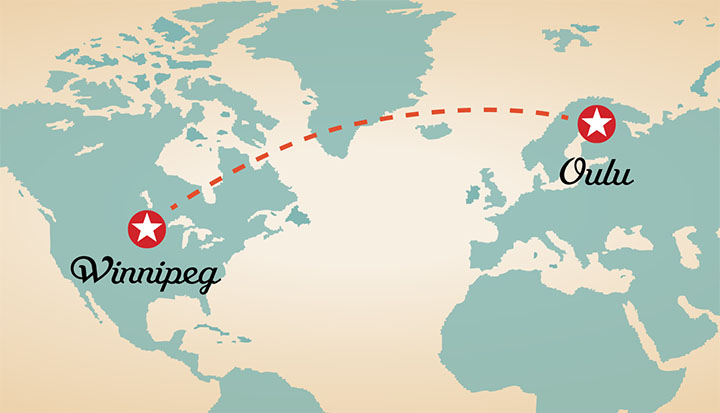 Back in the fall, I was invited to sit in on a CBC discussion about active transportation (as opposed to the inactive type, where the only exercise you get is texting or (if you’re me) giving people the finger). As a small group of us waited outside Stella’s for the doors to open and the sweet, sweet coffee to start flowing, I was introduced to Anders Swanson.
Back in the fall, I was invited to sit in on a CBC discussion about active transportation (as opposed to the inactive type, where the only exercise you get is texting or (if you’re me) giving people the finger). As a small group of us waited outside Stella’s for the doors to open and the sweet, sweet coffee to start flowing, I was introduced to Anders Swanson.
 In an attempt to make small talk and show off my worldliness, I asked him if he was part of Bike to the Future, or otherwise involved with cycling in some way. It turns out that was kind of like walking up to Jimmy Page and asking if he’s ever played an instrument. Of course he had no idea who I was either, confirming once again that my international fame is nothing but a figment of my own imagination.
In an attempt to make small talk and show off my worldliness, I asked him if he was part of Bike to the Future, or otherwise involved with cycling in some way. It turns out that was kind of like walking up to Jimmy Page and asking if he’s ever played an instrument. Of course he had no idea who I was either, confirming once again that my international fame is nothing but a figment of my own imagination.
Anders is currently in Oulu, Finland to attend the first ever International Winter Cycling Conference, where he will find out the latest about what makes a winter cycling city tick, besides a disproportionately large number of crazy people. He will also give a presentation about what the experience is like down here in the deep, deep South. From what I can gather through Anders’ words and pictures, Oulu is kind of like Copenhagen, but with less Danes and more snow.
Yesterday he sent a written report of his observations in Finland so far. I found it very interesting, and thought you might too. So put those files away and give it a read, because work is for suckers.
Anyway, here is Anders’ report:
First impressions of Oulu
This is my first day in the northern Finnish city of Oulu.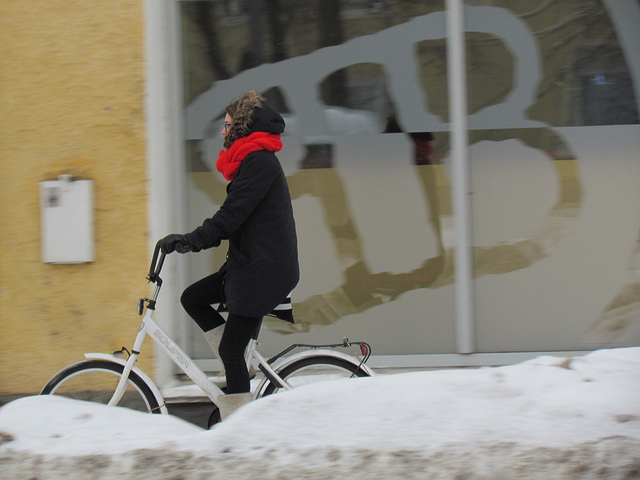 I have been in Finland for almost two weeks now, filming, documenting, interviewing and observing, visiting mainly two urban areas so far: Helsinki and Turku. People from Helsinki and Turku – at least the ones whom I had a chance to meet/asked what I was doing in Finland in February / had been to Oulu – were all effusive: they all told me that I hadn’t seen anything yet. “Wait for Oulu, if you want to see bikes”, they said. “This is nothing”, they said.
I have been in Finland for almost two weeks now, filming, documenting, interviewing and observing, visiting mainly two urban areas so far: Helsinki and Turku. People from Helsinki and Turku – at least the ones whom I had a chance to meet/asked what I was doing in Finland in February / had been to Oulu – were all effusive: they all told me that I hadn’t seen anything yet. “Wait for Oulu, if you want to see bikes”, they said. “This is nothing”, they said.
And they were right.
I spent this morning wandering around with a camera, and I didn’t have to wander far, or look for long, to find evidence. One step outside the hotel and it became clear. Everywhere you look, there are people on bikes. Tall people, short people. Fat people, skinny people. Old people, young people. Men, women, children. Able-bodied people and people with disabilities. Fashionable people (and not-so-fashionable people, me included).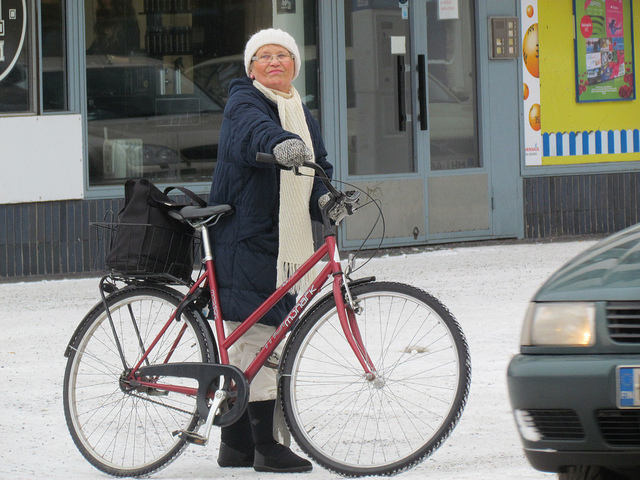 Keep in mind its the middle of winter…
Keep in mind its the middle of winter…
The typical bike they are riding is what we might call a dutch bike. Mostly black ones. The typical city bike. Sporting fenders and a rack and not much else. The occasional mountain or road bike appears, but they are in the minority. For some reason a lot of the city bikes are pink or red too. The next most popular colour seems to be light blue – like the Finnish flag.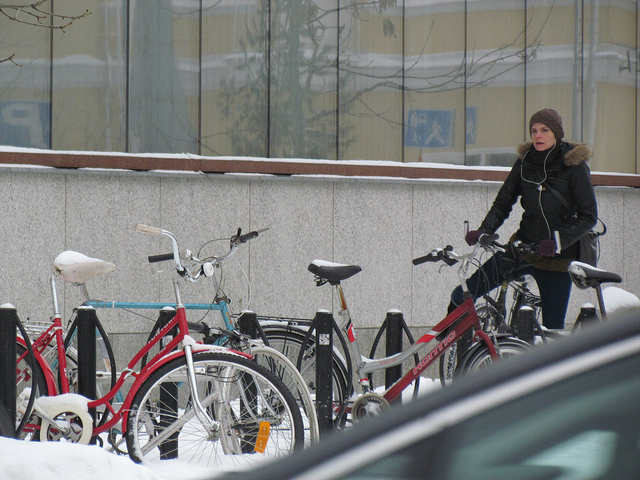 More importantly: Plain old steel frame. Comfy seat. No studded tires that I can see. No special equipment at all, really. Helmets are very rare. Maybe 1 in 20 or so. About the only special equipment I have seen are bike trailers (stuffed with kids), and an old adult trike for a gentleman that, when he parked it, clearly had mobility issues. My bike, its old steel frame sporting fancy wheels, shiny cranks and touring rack, looks almost spiffy here.
More importantly: Plain old steel frame. Comfy seat. No studded tires that I can see. No special equipment at all, really. Helmets are very rare. Maybe 1 in 20 or so. About the only special equipment I have seen are bike trailers (stuffed with kids), and an old adult trike for a gentleman that, when he parked it, clearly had mobility issues. My bike, its old steel frame sporting fancy wheels, shiny cranks and touring rack, looks almost spiffy here.
Baskets full of groceries and shopping bags are common. No room in the basket? Wup: The bread, the cheerios and the roll of toilet paper bags go on the handlebar and off we go. The bikes in the racks seem to outnumber parked cars. Riding with one hand on the handlebars is quite possible (more than a few young people are carrying a handbag, smoking a cigarette or chatting on cellphones while riding – possibly too self-conscious to wear a backpack, sneaking in one last drag at the last minute before work or arranging an a after-class meeting-point before heading to university. Not sure. You know: the things people do when they are on their way to work and not out to set a record. You get the impression that the bike is an afterthought here, not a intrinsic item. Simply a bit quicker than walking. No higher purpose. Exercise and environmentalism by association only. And it must be safe.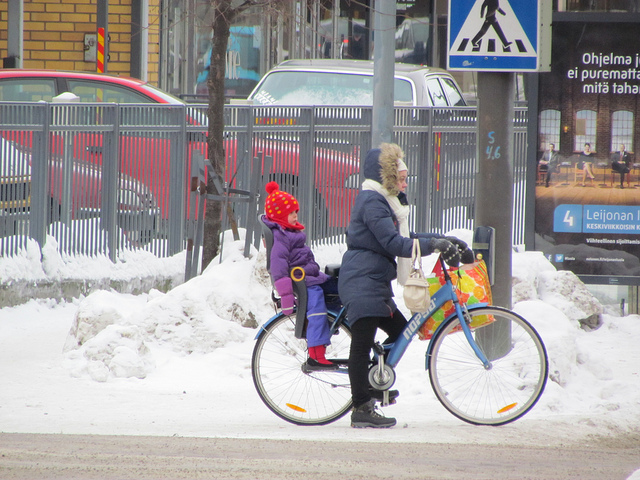 Most people are cycling alone, but more than a few are cycling along, side-by-side, as a couple or in groups, having conversations. They tend to stop often, entering stores. No joke. Not trying, yet again, to explain how bikes are good for business. I know because it is difficult to sometimes predict their behaviour when taking a video. They change their mind often, perhaps glancing into windows. It certainly is a lot quicker than trying to park a bike than a car. It’s funny to watch and compare the two trying to park. It’s also funny that people back home sometimes find it surprising that people can cycle in the winter. Here, it is even more apparent that cars are equally out of their element come wintertime. They get easily stuck in the icy, snowy parking spots, lose traction often and, when faced with throngs of bikes and pedestrians, seem to move about like frustrated, drugged-up, unwieldy rhinos.
Most people are cycling alone, but more than a few are cycling along, side-by-side, as a couple or in groups, having conversations. They tend to stop often, entering stores. No joke. Not trying, yet again, to explain how bikes are good for business. I know because it is difficult to sometimes predict their behaviour when taking a video. They change their mind often, perhaps glancing into windows. It certainly is a lot quicker than trying to park a bike than a car. It’s funny to watch and compare the two trying to park. It’s also funny that people back home sometimes find it surprising that people can cycle in the winter. Here, it is even more apparent that cars are equally out of their element come wintertime. They get easily stuck in the icy, snowy parking spots, lose traction often and, when faced with throngs of bikes and pedestrians, seem to move about like frustrated, drugged-up, unwieldy rhinos.
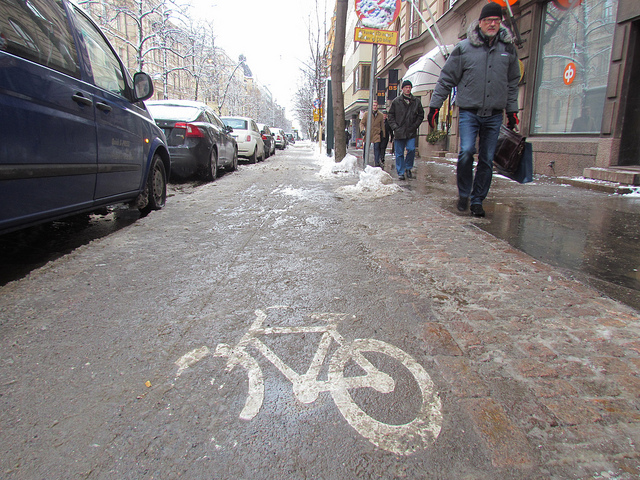 It is cold here too. Colder, actually, than home. I compared the weather in Winnipeg and Oulu on the internet, just to be sure I hadn’t gone soft. Yes, Oulu is on the ocean, which moderates things a bit – but this seems to be more than offset by the fact that it’s super far up north! There is snow too. Lots of it. It has been snowing constantly in Finland since I arrived – not sure about Oulu necessarily (because I just got here and because it seems like they make an extra effort to clear the pedestrian malls, sidewalks and bike paths) but definitely Helsinki and Turku were a snowy, blustery mess, and the snowbanks are fairly high at the moment, so I can only assume.
It is cold here too. Colder, actually, than home. I compared the weather in Winnipeg and Oulu on the internet, just to be sure I hadn’t gone soft. Yes, Oulu is on the ocean, which moderates things a bit – but this seems to be more than offset by the fact that it’s super far up north! There is snow too. Lots of it. It has been snowing constantly in Finland since I arrived – not sure about Oulu necessarily (because I just got here and because it seems like they make an extra effort to clear the pedestrian malls, sidewalks and bike paths) but definitely Helsinki and Turku were a snowy, blustery mess, and the snowbanks are fairly high at the moment, so I can only assume.
The landscape here in Oulu is quite similar to Winnipeg. In fact, compared to Helsinki, which feels very “continental European” and is so packed with stuff that it makes more sense to most people to just walk, the main part of Oulu doesn’t seem any more dense than, say, Osborne village. There certainly aren’t any skyscrapers, and the biggest building is certainly a lot smaller than Polo Park. It’s a university town, but so is Winnipeg. Like Winnipeg, Oulu is extremely flat.
I hesitate to draw any conclusions as to why winter cycling is happening in abundance here – or get into the numbers. Not yet, anyway. That will have to come later. I am here to learn after all. And for now, I am content to simply watch what’s going on.
Next steps
Tomorrow, the conference starts. On Thursday, I make my presentation. It was rather idealistically entitled “Winnipeg Winter Cycling Capital of North America“. Admittedly, that title should have been followed by a pretty big question mark. Crafted as it was at the last minute (with help from my generous compatriots at the Forks who likely have a more optimistic view on things thanks to the constant reinforcement of the nearby and very busy river trail), it might be a tough statement to pull off for someone who collects and analyzes (and ideally helps improve upon) bicycle and pedestrian data!
I am a bit sheepish about trying to back up that statement in a room full of the world’s leaders in this department – and with some Canadians and Americans in the room to boot. Even Yellowknife, with it’s much higher winter mode share, may be miffed, for example. I already got called out on Twitter by someone from Edmonton. Oh well. Too bad. A theoretical capital is something you get to self-declare, and if someone wants to fight for the title, they can.
There is no doubt that there is something special happening in Winnipeg – and I am glad people are paying attention. I will be quite proud to share what we are all working on. We can fight over who is truly the “capital” later. The recent summer mode share jump here is just one example of what is possible. And, if usage numbers on the one-of-a-kind Forks’ River Trail, the made-in-Winnipeg Winter Bike to Work Day’s expanding list of communities and the physical/climatological similarities to Oulu are all indications, then there are some very good reasons to think that Winnipeg just might emerge as a leader.
Anyway, I will be sure to bring along some good homegrown ideas to share on our behalf – and feel that they are indeed worth sharing with an international audience.
Thanks for the update, Anders. Great job. And way to stick it to Yellowknife!
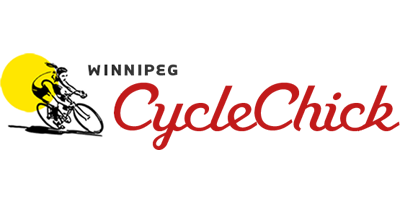
Inspiring.
As soon as I saw Oulu in the title I knew this would be cool. My cousin lived in Oulu for a few years while doing his Master’s there and always talked about the Finnish love of riding bike, even in winter. It’s great that Winnipeg will have some representation at this event (can’t wait to hear more about it) and hopefully our civic, provincial and even national leaders will eventually warm up to the need for better cycling infrastructure. I often get the “Wow, you’re dedicated/crazy for commuting all winter!” but after a few moments of explanation those individuals sometimes come around to the logic of it. Not often unfortunately but sometimes. So for now I’ll keep being one of those “crazy” people that bikes to work every day (in every season).
This is awesome. I’m so glad there are people out there that are pushing the issue and making things happen.
This is interesting, exciting and motivating. We may be the ‘capital’ but it is great to see there are many more ‘crazees’ [sp]. Better get Winnipeg drivers to smell the coffee. We aren’t going away.
Honestly I think other Canadian cities trying to compete for the title might be the egging on more folks around here need to commit to it. Would also help if the city would plow our multi-use trails after a big dump of snow…
[…] Anders Swanson’s first report from Oulu […]
[…] that are brash enough to declare themselves “world-class”. And while it is certainly no Oulu, compared to Winnipeg this time of year, there are bikes everywhere.Perhaps this is indicative of […]
Congrats on the very cool journey. Please address the lack of helmets. I was shocked by the riders even with children that had no head protection!
Maybe the Finns know something about the risks of head injury on bikes that North Americans aren’t willing to accept. 🙂
[…] http://winnipegcyclechick.com/?p=5959 […]
[…] http://winnipegcyclechick.com/?p=5959 […]
Only 1 in 20 wear helmets! Holy crap their society must be falling apart. lol 🙂
This article caught my eye because my friend visited Oulu a few years back when he competed in the “World Air Guitar Championships”. He placed 2nd! 🙂
Good luck making Winnipeg into the Winter Cycling Capital. You’ve got the perfect terrain for cycling (flat). Just have to convince people that cycling in the winter is totally doable. I personally haven’t found out how to do that yet. Where I live everyone has already formed an opinion on winter cycling and not many of them (as in none) are willing to experience it to see if their assumptions are correct. Even myself before I started biking in the winter used to think winter cyclists were crazy. Then i tried it and realized that all my assumptions were wrong. Just difficult to convince other people of that.
[…] winter cycling, including a presentation by Anders Swanson, who, as you will recall, attended the International Winter Cycling Congress in Oulu, Finland this winter. There will also be a remote presentation from Finland (since it was […]
Love this! I sent your more recent post about winter cycling to a friend in Seattle, trying to convey to him the lunacy of planning a February ski vacation in Wisconsin, this early. He replied with, “Hey, let’s go to that bike conference in Finland! Cheers.
loooksss Cold overthere but great biking attitude they have for sure